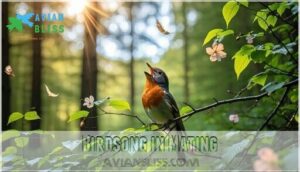This site is supported by our readers. We may earn a commission, at no cost to you, if you purchase through links.
 You’ll find that birds sing for six remarkable reasons that serve essential survival functions.
You’ll find that birds sing for six remarkable reasons that serve essential survival functions.
They use their voices to attract mates during breeding season, defend their territory from rivals, and maintain social bonds within flocks.
Birds also sing to establish dominance hierarchies, express emotions like joy or alarm, and practice their vocal skills much like musicians rehearsing.
Each species has developed unique songs that act as a complex language system, conveying everything from "this territory is taken" to "I’m healthy and ready to mate".
These vocalizations involve intricate anatomical structures and learned behaviors that vary across regions and generations.
The science behind these melodies reveals fascinating secrets about avian intelligence and survival strategies.
Table Of Contents
Key Takeaways
- You’ll hear birds sing for survival, not joy – Their songs serve six critical functions: attracting mates, defending territory, maintaining social bonds, establishing dominance, expressing emotions, and practicing vocal skills
- Birds use sophisticated vocal anatomy you don’t have – The syrinx allows them to produce complex dual-pitch melodies simultaneously, creating intricate communication systems that surpass human vocal abilities
- Each song carries specific survival messages – When you hear birdsong, you’re listening to territorial warnings, mating advertisements, health reports, and social coordination calls that determine life-or-death outcomes
- Human activity is silencing these natural orchestras – Songbird populations have dropped 29% since 1970 due to habitat destruction, climate change, and noise pollution, making conservation efforts critical for preserving these communication systems
Birds Singing Behavior
You’ve likely heard birds singing outside your window and wondered what drives this beautiful behavior.
Birds produce complex vocalizations through their syrinx, a unique vocal organ that allows them to create intricate melodies for mate attraction, territory defense, and social communication with remarkable precision.
Nature’s most sophisticated musicians perform their concerts through a remarkable biological instrument that puts human vocal abilities to shame.
Birdsong Functions and Communication
You’ll discover that birds use their voices as nature’s most sophisticated communication system.
Over 4,000 songbird species rely on vocalizations to navigate daily life, creating a complex network of acoustic signals that serves multiple functions:
- Recognition Signals – Birds identify family members, species, and individuals through unique vocal signatures that act like auditory fingerprints in their communities.
- Social Bonding – Vocal imitation strengthens relationships within flocks, while coordinated singing promotes group cohesion and maintains social hierarchies during non-breeding seasons.
- Flock Coordination – Alarm calls warn of dangers without revealing the caller’s location, while flight calls keep migrating groups together across vast distances.
Birds also follow the language shortcuts principle to efficiently communicate.
Types of Bird Vocalizations
You’ll hear five distinct bird vocalizations, each serving specific purposes.
Alarm calls are sharp, brief warnings that don’t reveal the caller’s location. Flight sounds help flocks stay connected during travel, while begging calls—those repetitive shrieks—demand parental attention.
Courtship songs attract mates through melodic complexity. Territorial chirps mark boundaries and warn intruders.
These varied bird communications showcase sophisticated vocal mimicry systems and highlight the importance of bird vocalizations.
Birdsong Learning and Variation
You’ll find that young birds don’t just magically know their species’ songs—they’re actually skilled mimics learning through careful observation.
Song imitation drives generational transmission, creating fascinating vocal dialects across regions.
- Learning patterns: Young songbirds practice extensively, mimicking adult males until they master complex vocalizations
- Regional accents: Bird populations develop distinct vocal dialects based on local song traditions
- Song complexity: Species vary dramatically in repertoire size, from simple calls to elaborate musical compositions
- Bird vocal learning: This cultural transmission shapes song evolution across generations
Why Do Birds Sing
You’ve experienced their elaborate vocal displays, but the reasons behind bird songs reveal nature’s most sophisticated communication system.
Birds sing to communicate critical information about survival, reproduction, and social coordination.
Their songs function as biological GPS systems, helping them navigate complex social landscapes while maintaining species identity across generations.
Birdsong Evolution shaped these vocalizations over millions of years, creating distinct Song Patterns that serve multiple purposes.
Avian Hearing detects subtle frequency variations that human ears miss, while specialized Brain Structure processes these acoustic signals with remarkable precision.
Bird songs represent one of nature’s most complex forms of avian vocalization, combining learned behaviors with instinctive responses.
The process of learning and development is influenced by bird song anatomy, which enables young birds to master complex repertoires.
| Primary Function | Signal Type | Audience |
|---|---|---|
| Mate attraction | Mating songs | Potential partners |
| Territory marking | Territorial defense | Rival males |
| Species recognition | Identity calls | Same species |
| Alarm warnings | Alert sounds | Flock members |
| Social bonding | Contact calls | Mate/offspring |
This Vocal Anatomy enables bird vocal learning, where young birds master complex repertoires through careful imitation, creating regional dialects that persist across generations.
Birdsong Production
You’ll discover that birds don’t just open their beaks and magically produce song—they’re actually operating sophisticated biological sound systems that put human vocal cords to shame.
The secret lies in a remarkable organ called the syrinx, which works like a natural dual-channel mixer, allowing birds to create complex melodies that would make any musician envious.
The Syrinx and Its Role
You’ll discover something remarkable about how birds create their beautiful melodies.
The syrinx, your feathered friend’s vocal organ, sits where the trachea splits into two bronchi.
Unlike humans who use vocal cords, birds rely on this specialized structure for sound production.
Each side operates independently, allowing simultaneous dual-pitch creation.
Complex syrinx anatomy enables songbirds to produce intricate melodies through precise muscle control.
Understanding the basics of bird communication methods is essential to appreciating the complexity of their songs.
Anatomy of Birdsong
You’ll be amazed at what happens inside a bird’s chest when it sings.
The syrinx transforms your bird’s chest into nature’s most advanced sound studio.
The syrinx sits deep in their respiratory system, where the trachea splits into two bronchi.
This remarkable vocal organ creates the magic through specialized structures:
- Vibrating membranes that flutter like tiny drumheads
- Air sacs that act as biological bellows
- Muscular rings that fine-tune each note
- Dual pathways allowing simultaneous sound production
Unlike your larynx, birds control their syrinx with incredible precision, making their complex vocalizations possible.
The study of vocal organs involves understanding complex vocal organ kits that mimic these biological processes.
Control of Pitch and Volume
Birds masterfully control their syrinx function through precise muscle adjustments, creating remarkable vocal control over pitch regulation and volume adjustment.
You’ll discover they manipulate airflow and muscle tension to produce diverse acoustic signals, with some species achieving extraordinary vocal range spanning multiple octaves.
This sophisticated sound production system enables complex bird vocalizations, showcasing millions of years of bird song evolution in action, with a remarkable ability to produce diverse acoustic signals.
Birdsong in Mating
You’ve probably noticed that male birds become incredibly vocal during mating season, transforming quiet neighborhoods into symphony halls of competitive singing.
Their elaborate songs aren’t just for show—they’re sophisticated advertisements that reveal everything from genetic fitness to territory quality.
Helping females choose the best possible mates while warning rivals to stay away is the ultimate goal, making these songs competitive singing and a display of genetic fitness.
Mate Attraction and Selection
When male birds open their beaks in courtship, they’re basically auditioning for love.
Female preference drives mate choice through song complexity assessment, with larger vocal repertoires correlating to 30% higher mating success.
These vocal displays serve as honest signals of male fitness, revealing cognitive abilities and developmental health through intricate courtship rituals that have shaped bird song evolution.
Territorial Defense and Rival Repulsion
When you hear that dawn chorus, you’re witnessing nature’s property disputes in action.
Male birds strategically position themselves on prominent perches, broadcasting territorial boundaries through song before rivals wake up.
These vocal Threat Signals effectively delay intrusions without physical confrontation.
Song type matching and repertoire battles communicate territorial strength, while Border Disputes get resolved through melodic showdowns rather than energy-draining fights.
This behavior is a key aspect of territorial defense strategies that help birds maintain their territory and resources.
Signaling Overall Health
When you listen to a bird’s morning serenade, you’re actually hearing a detailed health report.
Disease Warning signs and Parasite Detection become obvious through weakened songs, while robust melodies serve as Fitness Indicators.
Healthy birds produce stronger, more complex vocalizations that function as Vigor Signs, allowing potential mates to assess overall condition through animal communication patterns during bird behavior displays, which include clear Disease Warning signs.
Conservation of Songbirds
While you enjoy the beautiful melodies birds create, their songs face unprecedented threats from habitat loss, climate change, and human development.
Your support for conservation efforts and bird-friendly policies can help protect these remarkable vocal artists for future generations to hear and appreciate.
Human Impact on Songbird Populations
While birdsong’s beauty captivates us, human activities are silencing these natural orchestras at an alarming rate.
You’re witnessing a crisis where songbird populations have plummeted by 29% since 1970, with nearly three billion birds lost to our expanding footprint.
Human Impact on Songbird Populations includes:
- Habitat Destruction – Urban development fragments forests, isolating bird communities and reducing breeding success rates to dangerous lows
- Climate Change – Rising temperatures disrupt migration timing, forcing birds to arrive at breeding grounds before food sources are available
- Noise Pollution – Traffic and industrial sounds mask mating calls, shrinking communication ranges by 20% in affected areas
Urbanization Effects create ecological dead zones where once-thriving bird habitats supported diverse songbird populations.
Environmental science research reveals that forest fragmentation around cities increases local extinction rates dramatically.
Conservation Policies struggle to keep pace with rapid development, leaving critical bird habitats vulnerable to destruction and degradation.
Human impact on bird conservation extends beyond visible changes, affecting the intricate timing systems that songbirds rely on for survival and reproduction success.
The use of neonicotinoid pesticides can have devastating effects on songbird populations, further exacerbating the crisis.
Conservation Efforts and Advocacy
Organizations worldwide are stepping up bird conservation efforts through coordinated programs and funding initiatives.
The Association of Zoos and Aquariums’ SAFE North American Songbird Program unites institutions to implement research-based conservation biology strategies.
Meanwhile, the Songbird Conservation Catalyst Fund allocates millions for species protection and wildlife conservation projects, targeting trade reduction and habitat preservation through sustainability efforts.
Effective bird conservation requires the use of specialized Bird Conservation Products to support these initiatives.
Importance of Habitat Protection
Beyond protecting individual species, habitat preservation creates a ripple effect that strengthens entire ecosystems.
When you support wildlife conservation efforts, you’re investing in environmental sustainability that benefits countless songbird species.
Biodiversity protection through ecosystem conservation guarantees birds have safe nesting sites, abundant food sources, and migration corridors.
Your advocacy for habitat protection directly impacts environmental conservation success, maintaining the delicate ecosystem balance that keeps our feathered friends singing.
Effective conservation relies on understanding the importance of habitats to develop targeted preservation strategies.
Frequently Asked Questions (FAQs)
Why do birds sing so much at dawn?
Ever wonder why birds treat dawn like nature’s alarm clock?
You’ll hear their territorial songs because cooler air carries sound farther, helping males defend territory and attract mates more effectively before daily activities begin.
Why do birds sing?
You’ll hear birds singing to attract mates and defend their territories.
Males broadcast their health and vigor through complex songs, while both sexes use calls for daily communication like warning about predators or coordinating flock movements.
Why do female birds sing?
In seventy percent of songbird species, you’ll find females singing for territory defense and mate communication, particularly in tropical regions where competition demands vocal assertiveness.
How do birds learn to sing?
Young birds learn songs by mimicking adult males of their species, practicing repetitively until they master the correct patterns through cultural transmission and social learning.
What is bird singing biology?
Bird singing biology centers on the syrinx, a unique vocal organ located where your windpipes split.
You’ll find this bony structure enables simultaneous dual-pitch production, creating complex melodies through precise tension control and exhalation force adjustments.
Why do birds use songs?
You’ll find birds using songs primarily to attract mates and defend territories.
Males showcase their fitness through complex melodies, while both sexes communicate about food, danger, and social coordination within their communities, which is crucial for their communities.
What does it mean when birds sing?
About 4,000 songbird species exist worldwide, and when you hear their melodies, they’re communicating essential messages about territory, mating availability, and social coordination within their communities.
Do birds sing because they are happy?
No, birds don’t sing from happiness.
You’ll hear them vocalize primarily for practical purposes: attracting mates, defending territory, and communicating danger or location.
Their songs signal fitness and health to potential partners while warning rivals to stay away, which is a key aspect of communicating danger.
Why do birds like singing?
You’ll discover that birds don’t actually "like" singing in the way humans enjoy music.
Instead, they’re driven by powerful biological instincts to communicate survival needs, attract mates, and defend territories effectively, which is a key aspect of their survival.
How do songs differ from calls?
Songs are longer, more complex vocalizations learned for mate attraction and territory defense, while calls are shorter, simpler sounds used for immediate communication like danger warnings or flock coordination.
Conclusion
Like Shakespeare’s Juliet asking "What’s in a name?", understanding why do birds sing reveals nature’s intricate communication system.
You’ve discovered that birdsong serves six essential purposes: attracting mates, defending territory, maintaining social bonds, establishing dominance, expressing emotions, and practicing vocal skills.
These melodies aren’t just pleasant sounds—they’re survival tools that demonstrate remarkable intelligence. Next time you hear a robin’s dawn chorus, you’ll recognize the complex messages being shared in your backyard’s avian community.
- https://pmc.ncbi.nlm.nih.gov/articles/PMC9258629/
- https://projects.iq.harvard.edu/files/understanding_bird_songs/files/collins_vocal_fighting_flirting.pdf
- https://www.manchester.ac.uk/about/news/scientists-discover-surprising-language-shortcuts-in-birdsong--just-like-humans/
- https://www.sciencedirect.com/science/article/abs/pii/S0003347224002136
- https://www.sainsburywellcome.org/web/qa/music-neuroscience-decoding-brain-through-birdsong








